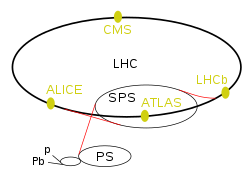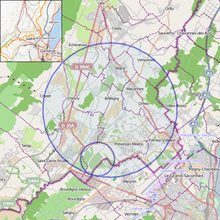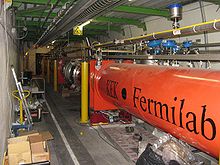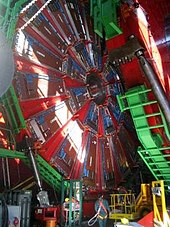Science
Labels: CERN - The Large Hadron Collider , Iftekhar Ahmed Fahmi.cinema , Large Hadron Collider , Large Hadron Collider lhc Videos for lhc , LHC Machine Outreach , News for lhc LHC , 0 comments
Coordinates: 46°14′N 06°03′E / 46.233°N 6.05°E
 | |||||||||||||||||||||||||||||||||||||||||||||||||||||
| LHC experiments | |||||||||||||||||||||||||||||||||||||||||||||||||||||
|---|---|---|---|---|---|---|---|---|---|---|---|---|---|---|---|---|---|---|---|---|---|---|---|---|---|---|---|---|---|---|---|---|---|---|---|---|---|---|---|---|---|---|---|---|---|---|---|---|---|---|---|---|---|
| ATLAS | A Toroidal LHC Apparatus | ||||||||||||||||||||||||||||||||||||||||||||||||||||
| CMS | Compact Muon Solenoid | ||||||||||||||||||||||||||||||||||||||||||||||||||||
| LHCb | LHC-beauty | ||||||||||||||||||||||||||||||||||||||||||||||||||||
| ALICE | A Large Ion Collider Experiment | ||||||||||||||||||||||||||||||||||||||||||||||||||||
| TOTEM | Total Cross Section, Elastic Scattering and Diffraction Dissociation | ||||||||||||||||||||||||||||||||||||||||||||||||||||
| LHCf | LHC-forward | ||||||||||||||||||||||||||||||||||||||||||||||||||||
| MoEDAL | Monopole and Exotics Detector At the LHC | ||||||||||||||||||||||||||||||||||||||||||||||||||||
| LHC preaccelerators | |||||||||||||||||||||||||||||||||||||||||||||||||||||
| p and Pb | Linear accelerators for protons (Linac 2) and Lead (Linac 3) | ||||||||||||||||||||||||||||||||||||||||||||||||||||
| (not marked) | Proton Synchrotron Booster | ||||||||||||||||||||||||||||||||||||||||||||||||||||
| PS | Proton Synchrotron | ||||||||||||||||||||||||||||||||||||||||||||||||||||
Super Proton Synchrotron
The Large Hadron Collider (LHC) is the world's largest and highest-energy particle accelerator. It is expected that it will address the most fundamental questions of physics, advancing our understanding of the deepest laws of nature. The LHC lies in a tunnel 27 kilometres (17 mi) in circumference, as much as 175 metres (574 ft) beneath the Franco-Swiss border near Geneva, Switzerland. This synchrotron is designed to collide opposing particle beams of either protons at an energy of 7 teraelectronvolts (1.12 microjoules) per particle, or lead nuclei at an energy of 574 TeV (92.0 µJ) per nucleus. The term hadron refers to particles composed of quarks. The Large Hadron Collider was built by the European Organization for Nuclear Research (CERN) with the intention of testing various predictions of high-energy physics, including the existence of the hypothesized Higgs boson and of the large family of new particles predicted by supersymmetry. It is funded by and built in collaboration with over 10,000 scientists and engineers from over 100 countries as well as hundreds of universities and laboratories. On 10 September 2008, the proton beams were successfully circulated in the main ring of the LHC for the first time, but 9 days later operations were halted due to a serious fault.On 20 November 2009 they were successfully circulated again,with the first proton–proton collisions being recorded 3 days later at the injection energy of 450 GeV per beam. After the 2009 winter shutdown, the LHC was restarted and the beam was ramped up to 3.5 TeV per beam,half its designed energy, which is planned for after its 2012 shutdown. On 30 March 2010, the first planned collisions took place between two 3.5 TeV beams, which set a new world record for the highest-energy man-made particle collisions. The Large Hadron Collider (LHC) is the world's largest and highest-energy particle accelerator. It is expected that it will address the most fundamental questions of physics, advancing our understanding of the deepest laws of nature. The LHC lies in a tunnel 27 kilometres (17 mi) in circumference, as much as 175 metres (574 ft) beneath the Franco-Swiss border near Geneva, Switzerland. This synchrotron is designed to collide opposing particle beams of either protons at an energy of 7 teraelectronvolts (1.12 microjoules) per particle, or lead nuclei at an energy of 574 TeV (92.0 µJ) per nucleus. The term hadron refers to particles composed of quarks. The Large Hadron Collider was built by the European Organization for Nuclear Research (CERN) with the intention of testing various predictions of high-energy physics, including the existence of the hypothesized Higgs bosonand of the large family of new particles predicted by supersymmetry. It is funded by and built in collaboration with over 10,000 scientists and engineers from over 100 countries as well as hundreds of universities and laboratories. On 10 September 2008, the proton beams were successfully circulated in the main ring of the LHC for the first time, but 9 days later operations were halted due to a serious fault.On 20 November 2009 they were successfully circulated again, with the first proton–proton collisions being recorded 3 days later at the injection energy of 450 GeV per beam. After the 2009 winter shutdown, the LHC was restarted and the beam was ramped up to 3.5 TeV per beam,half its designed energy,which is planned for after its 2012 shutdown. On 30 March 2010, the first planned collisions took place between two 3.5 TeV beams, which set a new world record for the highest-energy man-made particle collisions. DesignThe 3.8-metre (12 ft) wide concrete-lined tunnel, constructed between 1983 and 1988, was formerly used to house the Large Electron–Positron Collider. It crosses the border between Switzerland and France at four points, with most of it in France. Surface buildings hold ancillary equipment such as compressors, ventilation equipment, control electronics and refrigeration plants. The collider tunnel contains two adjacent parallel beam pipes that intersect at four points, each containing a proton beam, which travel in opposite directions around the ring. Some 1,232 dipole magnets keep the beams on their circular path, while an additional 392 quadrupole magnets are used to keep the beams focused, in order to maximize the chances of interaction between the particles in the four intersection points, where the two beams will cross. In total, over 1,600 superconducting magnets are installed, with most weighing over 27 tonnes. Approximately 96 tonnes of liquid helium is needed to keep the magnets at their operating temperature of 1.9 K (−271.25 °C), making the LHC the largest cryogenic facility in the world at liquid helium temperature. Prior to being injected into the main accelerator, the particles are prepared by a series of systems that successively increase their energy. The first system is the linear particle accelerator LINAC 2 generating 50-MeV protons, which feeds the Proton Synchrotron Booster (PSB). There the protons are accelerated to 1.4 GeV and injected into the Proton Synchrotron (PS), where they are accelerated to 26 GeV. Finally the Super Proton Synchrotron (SPS) is used to further increase their energy to 450 GeV before they are at last injected (over a period of 20 minutes) into the main ring. Here the proton bunches are accumulated, accelerated (over a period of 20 minutes) to their peak 7-TeV energy, and finally circulated for 10 to 24 hours while collisions occur at the four intersection points. The LHC physics program is mainly based on proton–proton collisions. However, shorter running periods, typically one month per year, with heavy-ion collisions are included in the program. While lighter ions are considered as well, the baseline scheme deals with lead ions (see A Large Ion Collider Experiment). The lead ions will be first accelerated by the linear accelerator LINAC 3, and the Low-Energy Ion Ring (LEIR) will be used as an ion storage and cooler unit. The ions will then be further accelerated by the PS and SPS before being injected into LHC ring, where they will reach an energy of 2.76 TeV per nucleon (or 575 TeV per ion), higher than the energies reached by the Relativistic Heavy Ion Collider. The aim of the heavy-ion program is to investigate quark–gluon plasma, which existed in the early universe. PurposePhysicists hope that the LHC will help answer many of the most fundamental questions in physics: questions concerning the basic laws governing the interactions and forces among the elementary objects, the deep structure of space and time, especially regarding the intersection of quantum mechanics and general relativity, where current theories and knowledge are unclear or break down altogether. These issues include, at least:
Safety of particle collisionsMain article: Safety of particle collisions at the Large Hadron Collider The experiments at the Large Hadron Collider sparked fears among the public that the particle collisions might produce doomsday phenomena, involving the production of stable microscopic black holes or the creation of hypothetical particles called strangelets. Two CERN-commissioned safety reviews examined these concerns and concluded that the experiments at the LHC present no danger and that there is no reason for concern, a conclusion expressly endorsed by the American Physical Society.Construction accidents and delays
CostWith a budget of 9 billion US dollars (approx. €7.5bn or £6.19bn as of Jun 2010), the LHC is one of the most expensive scientific instruments ever built. The total cost of the project is expected to be of the order of 4.6bn Swiss francs (approx. $4.4bn, €3.1bn, or £2.8bn as of Jan 2010) for the accelerator and SFr 1.16bn (approx. $1.1bn, €0.8bn, or £0.7bn as of Jan 2010) for the CERN contribution to the experiments.The construction of LHC was approved in 1995 with a budget of SFr 2.6bn, with another SFr 210M towards the experiments. However, cost overruns, estimated in a major review in 2001 at around SFr 480M for the accelerator, and SFr 50M for the experiments, along with a reduction in CERN's budget, pushed the completion date from 2005 to April 2007.The superconducting magnets were responsible for SFr 180M of the cost increase. There were also further costs and delays due to engineering difficulties encountered while building the underground cavern for the Compact Muon Solenoid, and also due to faulty parts provided by Fermilab. Due to lower electricity costs during the summer, it is expected that the LHC will normally not operate over the winter months, although an exception was made to make up for the 2008 start-up delays over the 2009/10 winter.  The Large Hadron ColliderOur understanding of the Universe is about to change...The Large Hadron Collider (LHC) is a gigantic scientific instrument near Geneva, where it spans the border between Switzerland and France about 100 m underground. It is a particle accelerator used by physicists to study the smallest known particles – the fundamental building blocks of all things. It will revolutionise our understanding, from the minuscule world deep within atoms to the vastness of the Universe.Two beams of subatomic particles called 'hadrons' – either protons or lead ions – will travel in opposite directions inside the circular accelerator, gaining energy with every lap. Physicists will use the LHC to recreate the conditions just after the Big Bang, by colliding the two beams head-on at very high energy. Teams of physicists from around the world will analyse the particles created in the collisions using special detectors in a number of experiments dedicated to the LHC. There are many theories as to what will result from these collisions, but what's for sure is that a brave new world of physics will emerge from the new accelerator, as knowledge in particle physics goes on to describe the workings of the Universe. For decades, the Standard Model of particle physics has served physicists well as a means of understanding the fundamental laws of Nature, but it does not tell the whole story. Only experimental data using the higher energies reached by the LHC can push knowledge forward, challenging those who seek confirmation of established knowledge, and those who dare to dream beyond the paradigm. News of LHC Download video Videos for lhc
| |||||||||||||||||||||||||||||||||||||||||||||||||||||
 RSS Feed
RSS Feed Twitter
Twitter








0 Response to "Science"
Post a Comment
Don't Forget to Thanks us !